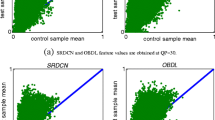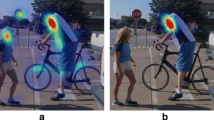Abstract
Visual saliency models aim at predicting where people look. In free viewing conditions, people look at relevant objects that are in focus. Assuming blurred or out-of-focus objects do not belong to the region of interest, this paper proposes a significant improvement and the validation of a saliency model by taking blur into account. Blur identification is associated to a spatio-temporal saliency model. Bottom-up models are designed to mimic the low-level processing of the human visual system and can thus detect out-of-focus objects as salient. The blur identification allows decreasing saliency values on blurred areas while increasing values on sharp areas. In order to validate our new saliency model we conducted eye-tracking experiments to record ground truth of observer’s fixations on images and videos. Blur identification significantly improves fixation prediction for natural images and videos.
Access this chapter
Tax calculation will be finalised at checkout
Purchases are for personal use only
Preview
Unable to display preview. Download preview PDF.
Similar content being viewed by others
References
Khan, R.A., Konik, H., Dinet, E.: Enhanced image saliency model based on blur identification. In: 25th International Conference of IVCNZ (December 2010)
Le Meur, O., Le Callet, P., Barba, D.: Predicting visual fixations on video based on low-level visual features. Vision Res. 47(19), 2483–2498 (2007)
Itti, L., Koch, C., Niebur, E.: Model of saliency-based visual attention for rapid scene analysis. IEEE PAMI 20, 1254–1259 (1998)
Daly, S.: The visible differences predictor: An algorithm of image fidelity. In: Digital Images and Human Vision, pp. 179–206 (1993)
Mannos, J.L., Sakrison, D.J.: The effects of a visual fidelity criterion on the encoding of images. IEEE TIT 20(4), 525–536 (1974)
Urban, F., Follet, B., Chamaret, C., Le Meur, O., Baccino, T.: Medium Spatial Frequencies, a Strong Predictor of Salience. Cogn. Comput. 3, 37–47 (2011)
Le Meur, O., Thoreau, D., Le Callet, P., Barba, D.: A spatio-temporal model of the selective human visual attention. In: IEEE ICIP, vol. 3, pp. 1188–1191 (2005)
Koch, C., Ullman, S.: Shifts in selective visual attention: towards the underlying neural circuitry. Hum Neurobiol. 4, 219–227 (1985)
Tong, H.: Blur detection for digital images using wavelet transform. In: Proceedings of IEEE ICME, pp. 17–20 (2004)
Urban, F., Nezan, J.F., Raulet, M.: HDS, a real-time multi-DSP motion estimator for MPEG-4 H.264 AVC high definition video encoding. Springer Journal of Real-Time Image Processing 4, 23–31 (2009)
Peters, R., Iyer, A., Itti, L., Koch, C.: Components of bottom-up gaze allocation in natural images. Vision Research 45, 2397–2416 (2005)
Author information
Authors and Affiliations
Editor information
Editors and Affiliations
Rights and permissions
Copyright information
© 2012 Springer-Verlag Berlin Heidelberg
About this paper
Cite this paper
Baveye, Y., Urban, F., Chamaret, C. (2012). Image and Video Saliency Models Improvement by Blur Identification. In: Bolc, L., Tadeusiewicz, R., Chmielewski, L.J., Wojciechowski, K. (eds) Computer Vision and Graphics. ICCVG 2012. Lecture Notes in Computer Science, vol 7594. Springer, Berlin, Heidelberg. https://doi.org/10.1007/978-3-642-33564-8_34
Download citation
DOI: https://doi.org/10.1007/978-3-642-33564-8_34
Publisher Name: Springer, Berlin, Heidelberg
Print ISBN: 978-3-642-33563-1
Online ISBN: 978-3-642-33564-8
eBook Packages: Computer ScienceComputer Science (R0)




